LAKE SIBAYA
Fishing on the shore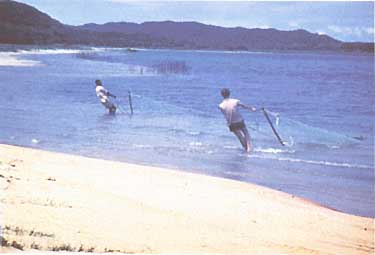
Photo: Departmet of Environment Affairs and Fisheries,
The Republic of South Africa
A. LOCATION
- Natal, South Africa.
- 27:20S, 32:20E; 23.35 m above sea level.
B. DESCRIPTION
-
Lake Sibaya is situated on the coast of the Indian Ocean in Natal Province, South Africa, near the boundary of Mozambique. The lake is surrounded by indented shorelines and has two elongated bays extending to the north and west. The surface area and mean depth are 77.5 km2 and 12.6 m. It is separated from the sea by coastal dunes only 2 km in width, and was presumably derived from an old lagoon which later became isolated by sand deposition. The water level is now 23 m above the sea surface, and fluctuates widely depending on rainfall and evaporation, because of the lack of outflowing rivers.
L. Sibaya and its surrounding area are known for the wealth of fauna containing not a few rare species and more than 200 species of birds, hippopotamus, crocodile, etc. Some 1,500 inhabitants on the lake coast live on agriculture and fishery, keeping traditional ways of fishing. Fishery products are partly exported to the other districts.
In the drainage basin, natural forests still survive mainly on sand dunes, but have been destroyed steadily owing to firewood harvest and clearing for agriculture. On the north and south sides of the lake, on the other hand, plantations of eucalypt and pine are expanding partly for use as pulp wood (1, 2, 9).
C. PHYSICAL DIMENSIONS (1, 2)
| Surface area [km2] | 78 |
| Volume [km3] | 0.981 |
| Maximum depth [m] | 43.0 |
| Mean depth [m] | 12.6 |
| Water level | Unregulated |
| Length of shoreline [km] | 126.9 |
| Catchment area [km2] | 465 |
D. PHYSIOGRAPHIC FEATURES
D1 GEOGRAPHICAL (1)- Bathymetric map: Fig. AFR-03-01.
- Names of main islands: None.
- Number of outflowing rivers and channels (name): None.
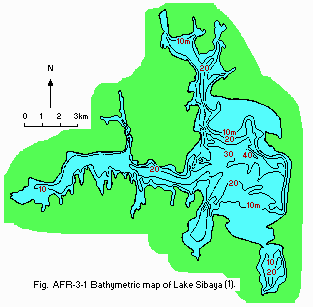
Bathymetric map (1).
D2 CLIMATIC
- Climatic data at Maputo*, 1931-1960 (3)
| Jan | Feb | Mar | Apr | May | Jun | Jul | Aug | Sep | Oct | Nov | Dec | Ann. | |
|---|---|---|---|---|---|---|---|---|---|---|---|---|---|
| Mean temp. [deg C] | 25.4 | 25.5 | 24.6 | 23.1 | 20.6 | 18.5 | 18.2 | 19.2 | 20.6 | 22.2 | 23.4 | 24.7 | 22.2 |
| Precipitation [mm] | 130 | 124 | 97 | 64 | 28 | 27 | 13 | 13 | 38 | 46 | 86 | 103 | 768 |
- Number of hours of bright sunshine: 2,748 hr yr-1 (3).
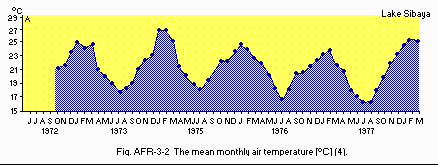
The mean monthly air temperature [deg C](4).
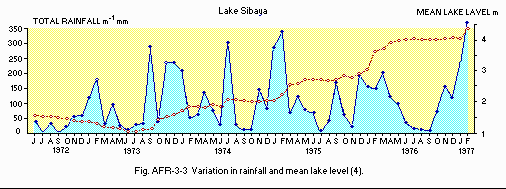
Variation in rainfall and mean lake level (4).
- Water temperature: Fig. AFR-03-02.
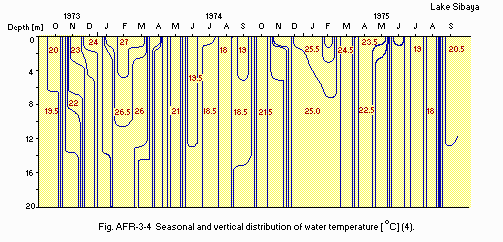
Seasonal and vertical distribution of water temperature [deg C](4).
- Freezing period: None (4).
- Mixing type: Polymictic (4).
E. LAKE WATER QUALITY
E4 DO [mg l-1 (%)](4)| Depth[m] | Jan 1967 | Jul | Jan 1968 | Mar 1970 | Jan 1977 |
|---|---|---|---|---|---|
| 0 | 7.6 (95) | 8.9 (100) | 7.3 (95) | 7.9 (99) | 8.0 (100) |
| 5 | 7.8 (98) | 8.9 (100) | 7.5 (96) | - | - |
| 10 | 8.0 (100) | 8.7 (97) | 6.8 (87) | - | 7.5 (94) |
| 15 | 8.1 (102) | 8.5 (95) | 6.4 (82) | 7.7 (97) | - |
| 20 | 8.1 (102) | 8.4 (94) | - | - | 7.4 (93) |
| 25 | - | 8.4 (94) | - | - | - |
| 30 | 6.9 (85) | 8.4 (94) | - | 7.0 (88) | 6.9 (87) |
| 35 | 6.6 (82) | 8.4 (94) | - | - | 4.8 (60) |
| 38 | - | - | 5.4 (68) | - | - |
| 39 | - | - | - | - | 4.5 (57) |

Seasonal variation in chlorophyll a (5).
E7 NITROGEN CONCENTRATION (4)
- Total Kjeldahl-N [micro g l-1]: 11.2-28.0.
- NO3-N [micro g l-1]: 17-32 (1967): 50.(1979)
- SRP (soluble reactive P)[micro g l-1](4)
| Year | SRP |
|---|---|
| 1967 | 25-55. |
| 1968 | 10-20. |
| 1970 | 14-25. |
| 1979 | 9 |
| Year | Cl-(no.of samples) |
|---|---|
| 1967-68 | 136-138 (34)* |
| 1970-71 | 132-149 (36) |
| 1975 | 125-127 (5) |
| 1979 | 142 (3) |
F. BIOLOGICAL FEATURES
F1 FLORA- Emerged macrophytes (7) Cyperus natalensis, Phragmites mauritianus, Scirpus littoralis, Typhalatifolia.
- Floating macrophytes: Nymphaea caerula, N. capensis (7).
- Submerged macrophytes (7) Ceratophyllum demersum, Myriophyllum spicatum, Najas pectinata, Potamogeton pectinatus, P. schweinfurthii, Utricularia inflexa.
- Phytoplankton (6) Closterium spp., Synedra acus, Anabaenopsis sp., Melosira granulata, Anabaenasp.
- Zooplankton (8) Pseudodiaptomus hessei, Thermocyclops emini, T. crassus consimilis, Bosmina longirostris, Moina sp.
- Benthos (8) Apseudes digitalis, Grandidierella lignorum, Corophium trienonyx, Cyathura carinata, Melanoides tuberculatus.
- Fish (9) Pseudocrenilabrus philander*, Sarotherodon mossambicus*, Tilapia rendalli sweirstrae, T. sparrmanii*, Croilia mossambica, Silhouettea sibayai, Clasias gariepinus*. * Economically important.
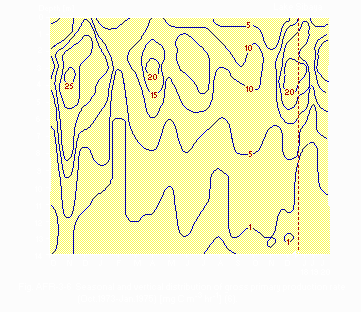
Seasonal and vertical distribution of gross primary production rate (October 1973-January 1975)[mg C m-3 hr-1](6).
F4 BIOMASS (7)
- Aboveground biomass of macrophytes
| Mean biomass [g m-2] | Area [km2] | Total biomass [t] | |
|---|---|---|---|
| Emerged | 417.7 | 6.06 | 2,531 |
| Submerged | 417.1 | 16.21 | 6,761 |
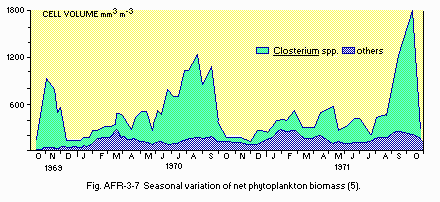
Seasonal variation of net phytoplankton biomass (5).
G. SOCIO-ECONOMIC CONDITIONS (2)
G1 LAND USE IN THE CATCHMENT AREA- Main types of woody vegetation Plantation of pine and eucalypt (ca. 70 km2).
- Main kinds of crops Maize, potato, sweet potato, groundnut, millet, kaffir corn, cassava, bean, banana, pumpkin, calabash and pawpaw.
- Secondary industry: Pulp mills.
The coastal zone (within 5 km from the shore) has a population of 1,451 and 631 huts.
H. LAKE UTILIZATION (2)
H1 LAKE UTILIZATIONFisheries.
A considerable number of inhabitants use water piped from the western arm of the lake to Mseleni Mission Hospital. Use rate (1975): 0.002 [m3 sec-1].
N. SOURCES OF DATA
- Hill, B. J. (1979) Bathymetry and hydrology of Lake Sibaya. Lake Sibaya (ed. Allanson, B. R.), pp. 21-33. Dr. W. Junk Publishers, The Hague.
- Bruton, M. N. (1979) The utilization and conservation of Lake Sibaya. Ibid., pp. 286-312.
- Muller, M. J. (1982) Selected Climatic Data for a Global Set of Standard Stations for Vegetation Science. 306 pp. Dr. W. Junk Publishers, The Hague.
- Allanson, B. R. (1979) The physico-chemical limnology of Lake Sibaya. Lake Sibaya (see above), pp.42-74.
- Hart, R. C. & Hart, R. (1977) Arch. Hydrobiol., 80: 85-107.
- Allanson, B. R. (1979) The phytoplankton and primary productivity of the lake. Lake Sibaya (see above), pp. 75-89.
- Howard-Williams, C. (1979) Distribution, biomass and role of aquatic macrophytes in Lake Sibaya. Ibid., pp. 88-107.
- Hart, R. C. (1979) The invertebrate communities: zooplankton, zoobenthos and littoral fauna. Ibid., pp. 108-161.
- Bruton, M. N. (1979) The fishes of Lake Sibaya. Ibid., pp. 162-245.


